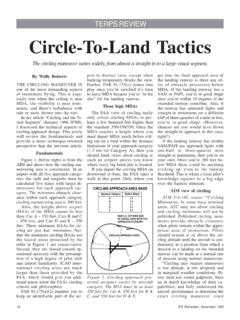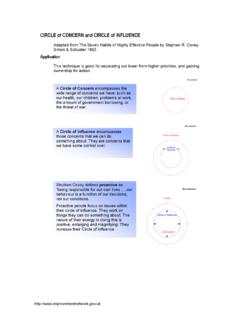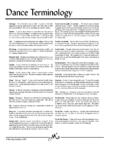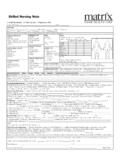Transcription of The Socratic Circle - CornDancer
1 1. The Socratic Circle What does Socratic mean? The word Socratic comes from the name Socrates (ca. 470-399 ), a Classical Greek philosopher who developed a Theory of Knowledge. What was Socrates' Theory of Knowledge? Socrates believed that the answers to all human questions and problems reside within us. Unfortunately, as human beings we are often unaware of the answers and solutions we possess. Socrates was convinced that the surest way to discover those answers and attain reliable knowledge was through the practice of disciplined conversation.
2 He called this method the dialectic. What does dialectic mean? Dialectic is the art or practice of examining opinions or ideas logically, often by the method of question and answer, so as to determine their validity. How did Socrates use the dialectic? Socrates believed that through the process of dialogue, where all parties to the conversation were forced to clarify their ideas, the final outcome of the conversation would be a clear statement of what was meant. The technique appears simple but it is intensely rigorous. Socrates would feign ignorance about a subject and try to draw out from the other person his fullest possible knowledge about it.
3 Socrates' assumption was that by progressively correcting incomplete or inaccurate notions through discussion, one could coax the truth out of anyone. What is a Socratic Circle ? A Socratic Circle (also called Socratic seminar) is a process to try to understand information by creating the dialectic in class in regards to a specific text. In a Socratic Circle , participants seek deeper understanding of complex ideas in the text through thoughtful dialogue, rather than by memorizing bits of information. A Socratic Circle is not debate. The goal of this activity is to have participants work together to construct 2.
4 Meaning and arrive at an answer, not for one student or one group to win the argument.. How does a Socratic Circle work? The ritualistic structure of a Socratic Circle is one that appears complex to participants at first, but ultimately that structure is what provides the students' growth and ownership of the conversation. The basic procedure for a Socratic Circle is as follows: 1. On the day before a Socratic Circle is scheduled, the teacher hands out a short passage of text. 2. That night at home, students spend time reading, analyzing, and taking notes over the section of text.
5 3. At the beginning of class the next day, students are randomly divided into two concentric circles: an inner Circle and an outer Circle . 4. Students in the inner Circle read the passage aloud and then engage in a discussion of the text for approximately ten minutes, while the outer Circle observes the human behavior and performance of the inner Circle . 5. Following this discussion of the text, the outer Circle then assesses the inner Circle 's performance and offers ten minutes of feedback for the inner Circle . 6. Students in the inner and outer Circle now exchange roles and positions within the classroom.
6 7. The new inner Circle (the students who began in the outer Circle ). holds a ten-minute discussion and then receives ten minutes of feedback from the new outer Circle . Of course there are many variations to the time limits of each aspect of Socratic Circle , but maintaining the discussion-feedback-discussion-feedback pattern is essential. 3. The Text: Socratic Circle texts are chosen for their richness in ideas, issues, and values and their ability to stimulate extended, thoughtful dialogue. A text can be drawn from readings in literature, history, science, math, health, and philosophy or from works of art or music.
7 A good text raises important questions in the participants' minds, questions for which there are no right or wrong answers. At the end of a successful Socratic Circle , participants often leave with more questions than they brought with them. (This is a good thing!). The Opening Question: A Socratic Circle opens with a question either posed by the leader or solicited from participants. An opening question has no right answer; instead it reflects a genuine curiosity on the part of the questioner. A good opening question leads participants back to the text as they speculate, evaluate, define, and clarify the issues involved.
8 Responses to the opening question generate new questions from the leader and participants, leading to new responses. In this way, the line of inquiry in a Socratic Circle evolves on the spot rather than being pre-determined by the leader. The Teacher: The teacher's role in this process is four-fold: 1) to select the text for discussion, 2) to keep the discussion of the inner Circle focused and moving, 3) to direct the feedback offered by the outer Circle , and 4) to assess the individual student and the group's performance. First, selecting a quality piece of text is crucial to the success of a Circle .
9 The text should be insightful, thought provoking, and relevant to the lives of students. Second, teachers should strive to interrupt the discussion of the inner Circle as infrequently as possible. The teacher's job is to act as a facilitator or coach for the discussion, not as the discussion's leader. For example, if the discussion begins to drift off-topic the teacher might pose a question to the group to help refocus and stimulate additional conversation. Or if the comments of one student need to be clarified or repeated for the group's understanding, the teacher should assist in that endeavor.
10 4. Third, teachers should guide the discussion of the outer Circle as they provide feedback and constructive criticism for the inner Circle . One of the most successful ways to accomplish this process is to simply go around the Circle and ask for initial observations. Once each student has offered an observation, the teacher can highlight particular points made and ask the group to brainstorm/predict solutions to any obstacle or problems noted following the cycle of reflective learning. Fourth, the teacher should assess each individual student and the group's performance as a whole in some manner, whether formally or informally.







